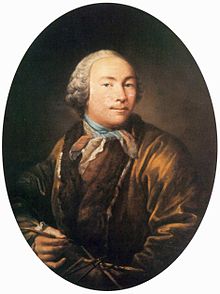Ivan Petrovich Argunov

Ivan Petrovich Argunow ( Russian Ива́н Петро́вич Аргуно́в ; * 1729 ; † 1802 in Moscow ) was a Russian painter and portraitist .
Life
Ivan Argunov was born into a serf family that belonged to the Russian Chancellor Prince Alexei Cherkassky and then passed on to him as part of the trousseau of his daughter Princess Varvara Alexejewna Cherkassky when she married Count Pyotr Sheremetev . Argunov grew up in the family of his uncle Semyon Mikhailovich Argunov, who was the servant of Princess Varwara Cherkassky and then steward Count Pyotr Sheremetev. For many years he ran the Sheremetev House on Millionnaya Street in St. Petersburg , where Ivan Argunov grew up.
1746–1749 Iwan Argunow studied painting with the German painter Georg Christoph Grooth , who was in the service of Empress Elisabeth and under whose direction Argunow created icons for the New Jerusalem monastery in Istra (1749) and the court church in Tsarskoe Selo (1753) . He also took lessons from his cousins Fyodor Leontjevich Argunow (1716–1754) and Fyodor Semjonowitsch Argunow (1732–1768), who worked as painters in the imperial residences in St. Petersburg. The early work The Dying Cleopatra (1750) was painted by Argunov in the academic rococo style. He painted his first known portraits in 1752 and 1754 according to Russian tradition with influences from the Baroque .
Argunov worked in Moscow, St. Petersburg and on the Sheremetev estates of Kuskovo and Ostankino . He created a long series of excellent portraits of the St. Petersburg aristocracy, especially the Tolstoy , the Lasarev and the Sheremetev. In doing so, he did not idealize the appearance of a person, so that he also reproduced cross-eyed eyes or puffiness. In 1762 he was commissioned to portray the Empress Catherine II . The portraits of children and young people occupy a special place in his work, in which he made the age-related and psychological characteristics clear in an impressive manner . He made the Kalmuck Annuschka particularly tender and soft . His masterpiece Portrait of a Stranger in Peasant Clothes was created in 1784. It probably depicts a serf wet nurse .
In addition to his painting art, Argunov also showed an educational talent. On the orders of Empress Elizabeth, the court singers started his apprenticeship after the change of voice : Anton Lossenko became a painter and director of the art academy , Kirill Golowachevsky became a painter and inspector of the academy's art school, and Ivan Sablukov became a painter and academician, while Fyodor Rokotow became a freelance portrait painter. He also trained his own sons: Pavel became an architect , and Jakow (1784–1830) and Nikolai became painters.
In 1770 Argunov was first steward of the Sheremetev House in St. Petersburg Millionnaja Street and later of the Moscow Sheremetew House. He was also a member of the serfs' college for the administration of the Sheremetev estates. From 1788 Argunov no longer painted and devoted himself only to the administration of Moscow's Sheremetev House. He was also involved in the construction of the Ostankino Palace Theater.
Web links
Individual evidence
- ↑ АРГУНОВ Иван Петрович (accessed September 21, 2016).
- ↑ Наталия Преснова: Все Аргуновы (accessed September 21, 2016).
- ↑ Иван Петрович Аргунов (1727–1802) (accessed September 21, 2016).
- ^ Dictionnaire des peintres, sculpteurs, dessinateurs et graveurs (Volume 1) . Gründ, Paris 1976, p. 255 .
- ↑ Т. А. Селинова: Иван Петрович Аргунов, 1729–1802 . Искусство, Moscow 1973.
- ↑ Tretyakov Gallery : Умирающая Клеопатра ( Memento of the original from July 8, 2016 in the Internet Archive ) Info: The archive link was inserted automatically and has not yet been checked. Please check the original and archive link according to the instructions and then remove this notice. (accessed on September 21, 2016).
- ↑ Аргунов, Иван Петрович (accessed September 21, 2016).
- ^ Richard Stites: Serfdom, Society, and the Arts in Imperial Russia . 2008, ISBN 978-0-300-13757-6 , pp. 333 .
| personal data | |
|---|---|
| SURNAME | Argunov, Ivan Petrovich |
| ALTERNATIVE NAMES | Аргуно́в, Ива́н Петро́вич (Russian) |
| BRIEF DESCRIPTION | Russian painter and portraitist |
| DATE OF BIRTH | 1729 |
| DATE OF DEATH | 1802 |
| Place of death | Moscow |